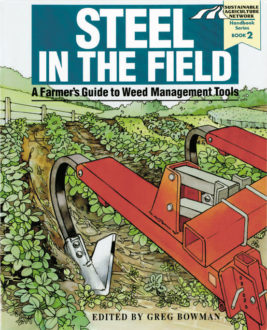How to Use This Book
A single tool can be used in many ways. So don't be limited by this book's presentation of tools in three general sections by cropping system:
Agronomic row crop tools (for corn, soybeans, grain sorghum and cotton) include broadcast tillage implements for early weed control, and tools that work between the rows as crops mature.
Horticultural crop tools include implements for bedded vegetables and for in-row weeding between plants or trees.
Dryland crop tools control weeds efficiently in vast fields while managing residue and conserving moisture during the fallow times between cropping periods.
Each section has two parts: 'The Tools' (technical information on each of its featured tools) followed by 'The Farmers' (narratives illustrating how farmers fit tools to their conditions).
The technical sections, outlined in detail below, feature drawings of important design elements. You learn here - at a glance - the facts of the tool. In their narratives, farmers explain how they integrate tools with the other parts of their weed management system - planting time, soil building, crop rotation and tillage mode. They provide you with the rest of the story - the art of the tool. Selecting the right technology is only part of the equation. A tool's wise use and adaptation to each farm are at least as important in making it part of a sustainable system.
The Tools
Two bar graphs begin the full-page entries. The top bar shows the estimated crop height range where the tool is most effective. The lower bar shows the estimated height range of weeds that the tool can handle.
The intensity of shading within the bars indicates the degree of certainty of the recommendation, i.e. the darker the shading, the more sure the effect. These are general guides reflecting a range of experiences. Actual effectiveness will vary according to your conditions and operating methods.
A tool overview summarizes how a tool works, its roles and important applications for weed management.
In design features, the mechanical and engineering highlights of the tool's shape, components and features are detailed.
Under model for comparison is a particular size of the tool - in some cases specifically outfitted - that is used for price comparison between makers. The 2001 list price figures were submitted by participating sources who also provided average PTO horsepower and field operating speed.
Width range, all makers/all models shows the widest and narrowest of all versions of a tool offered. Sources lists the reference number of commercial contacts found in 'Tool Sources' at the rear of the book. Farmers shows where to find the tool described in a farm narrative. Some tools were not used by any of the interviewed farmers.
The Farmers
Each farmer's narrative opens with general information about farm size, crops, soils, tillage style and cropping systems. Weed management highlights show the cultural steps and the tools used by the farmer. Boldface type highlights each farmer's first description of a tool that is illustrated in the Technical Section.
The Toolshed
Farmer sidebars add details to the narratives. Reviewers lists experts whose advice improved this book. The Glossary provides working definitions for tool-related terms. Horticultural tool sources includes contact information for specialty tractors suitable for cultivating (high clearance, offset fuselage, rear motor, light frame). Publications and information tells you how to learn more. Contacts gives ways to reach individuals willing to share of their knowledge.
Tool Sources is a numbered listing of tool manufacturers, North American distributors of foreign tools, and regional suppliers. The index lists tool text references, tool illustrations, farmers, tool parts, weeds varieties, tillage modes and cropping practices.
